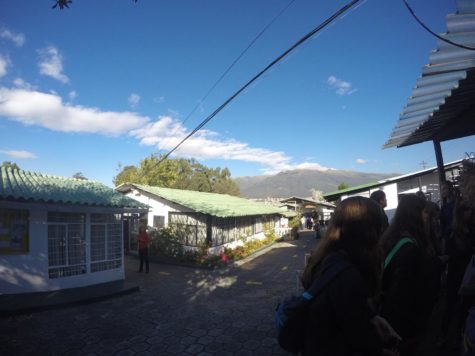The role of community in Yom Kippur
What we learned from the Jewish holiday of repentence
October 17, 2017
When we visited Temple Emanuel on the night of Yom Kippur, we saw flickering candles casting shadows on a gold backdrop of ancient designs and Hebrew scripture. We saw temple members mingle, shaking hands, and embracing one another. We saw musicians singing dulcet hymns and married couples holding hands. We saw generations of families singing the same lyrics and repeating the same liturgy. The room was filled with contemplation and devotion. We saw silence and we saw love.
As the service began, we looked out over a sea of heads dotted with kippahs (Jewish skullcaps), and felt a sense of peace and expectation. The atmosphere was solemn but not oppressive; it was a time of renewal. We rose with the congregation as the room darkened, lighting the little electric candles we had been given, and gingerly placing them in our palms. An ethereal beauty filled the room. Our eyes fell upon the Torahs as their procession up the aisle began, and our ears were filled with mystical Hebrew singing. A gentle wonder overcame us.
While observing the members of Temple Emanuel, we experienced the unity of the congregation and felt the impact of Yom Kippur on each individual.
“Judaism has given me a belief system and most importantly, a community,” Kathy Osborn, attendee of Temple Emanuel since 2001, said. “When I woke up this morning, I was thinking about seeing the people I loved at the ceremony.”
Rabbi Schadick added that when members of Temple Emanuel and of other communities treat each other like brothers and sisters, they “elevate life to a holy place.”
In perspective, the synagogue is only a larger form of the Jewish family, another religious community.
“Spending time with family is an important part of the holiday,” Tommer Andegecko ‘18 attendee of Chabad of Western Michigan, an orthodox synagogue, said. “My family wants us to understand the significance of it rather than participate blindly without any understanding.”
Jeanne Friedland, attendee of Temple Emanuel since 1986, also values having a strong Jewish family. She was successful in passing on Judaism’s principles and beliefs to her children.
“I grew up Jewish in Los Angeles,” Friedland said. “When I moved to East Grand Rapids, I had a kid. She came home from school at Lakeside with knowledge about Christmas trees and Santa Claus. And I thought, ‘Wait a minute, she’s getting a good Christian education in the public schools.’ I didn’t want that. So, I enrolled her in Sunday school.”
This sense of family and community is especially important during the hard times of persecution that Jews have experienced in the past and are experiencing now today.
“The acts of hatred against Jews reminds me that the world is not yet the place it ought to be,” Rabbi Schadick said. “To hate someone who is different is by definition anti-religious. Any faith that preaches hate in the name of a higher power is the very opposite of what religion stands for.”
Those of Jewish faith have begun to change the world for the better by first changing themselves. Just as the start of a new school year symbolizes a new beginning for students to improve on their mistakes from past years, Yom Kippur represents the beginning of a new year for those of the Jewish faith to repent their sins and live more blameless lives.
“A new year is a new chance,” Rabbi Schadick explained. “A new slate lays before us to alter our behavior and become better human beings. We look at ourselves as individuals and as a community and ask ourselves how we might be better in the new year.
Osborn has a similar perspective on the holiday.
“Yom Kippur is a time to reflect on our lives and how we might want to be different the next year,” she said. “It’s a reminder.”
Rabbi Schadick knows that in order to become different from the previous year, he must change the choices which shape his day-to-day life.
“Every day there can be holiness in each act that we choose to do or not do,” Rabbi Schadick explained. “Judaism reminds me of that.”



